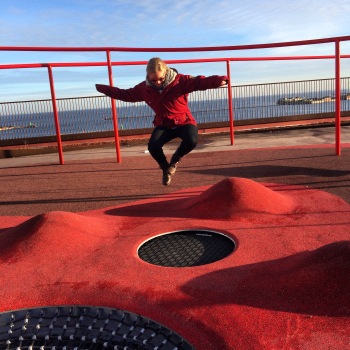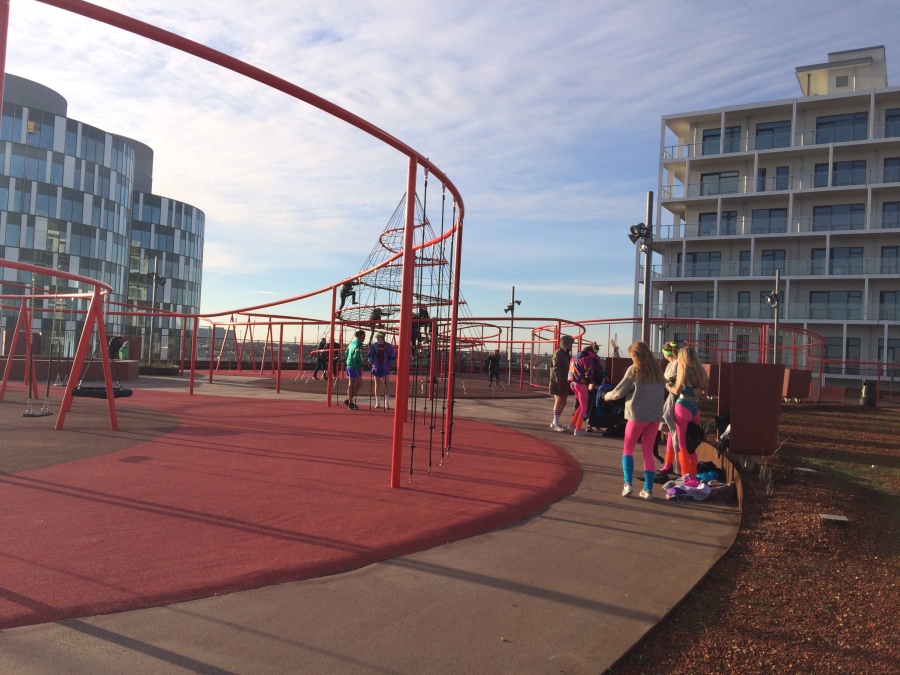 The Danish capital Copenhagen (population 760,000) offers numerous inspiring examples of how to create a sustainable city. Currently it is developing a new waterfront city district, Nordhavn, transforming an industrial port into a modern residential and business district. While still under development, interesting parts of the district are nearing completion, for example the district parking garage, Lüders P-hus. As a proponent of city cycling, it may seem strange to advocate for such a project. But, this is no ordinary parking garage.
The Danish capital Copenhagen (population 760,000) offers numerous inspiring examples of how to create a sustainable city. Currently it is developing a new waterfront city district, Nordhavn, transforming an industrial port into a modern residential and business district. While still under development, interesting parts of the district are nearing completion, for example the district parking garage, Lüders P-hus. As a proponent of city cycling, it may seem strange to advocate for such a project. But, this is no ordinary parking garage.
Lüders does contain 485 parking spots to accommodate the district’s future residents. It also contains bicycle parking, electric car charging stations and a recycling facility, all under the same roof. But, what is most exciting about this garage is not what is under the roof, but on top of it. On the roof of this parking garage is a 2400 m2 public space, with gardens, a playground, an outdoor gym, and swings and benches for lounging with friends, reading a book or simply taking in the fantastic views of the city and the sea – both seen from this spot. Adjoining the building are external staircases – and a giant yellow button for runners to time how long it takes to scale the staircase (and an internal elevator for wheelchairs or baby buggies to also enjoy the view).
 There is a set of rooftop trampolines, where you can gaze down at the floors below (admittedly a bit scary) and jungle gyms for “children” of all ages. Together with a friend, we spent 45 minutes on the rooftop, testing the different trampolines and climbing equipment. It was “urban research” after all. However, we were hardly the only non-children to do so. There were: families with young children; running groups in flashy pink leotards; and adults (without children to justify their playful behavior) bouncing on the trampolines, climbing the jungle gyms, or sharing a warm drink and a story.
There is a set of rooftop trampolines, where you can gaze down at the floors below (admittedly a bit scary) and jungle gyms for “children” of all ages. Together with a friend, we spent 45 minutes on the rooftop, testing the different trampolines and climbing equipment. It was “urban research” after all. However, we were hardly the only non-children to do so. There were: families with young children; running groups in flashy pink leotards; and adults (without children to justify their playful behavior) bouncing on the trampolines, climbing the jungle gyms, or sharing a warm drink and a story.
Copenhagen is world-renowned for its leading-edge sustainable city design, and this was also apparent at Lüders. Climbing plants and urban art, edged into the wrought-iron sides of the building, are some aspects of the building’s sustainable design. Still, a different component of sustainable city design becomes apparent with this project: the notion that environmental sustainability should go hand-in-hand with a focus on healthy lifestyles, which can and should encourage play, laughter and building community.
So while hardly a fan of parking garages, I love this fantastic rooftop, which has become an extension of the public space. Gazing out from that rooftop, I could see the sea, the skyline and the adjacent green roofs – an important climate change adaptation measure mandated by Copenhagen’s local government. Lüders offers a different method of ensuring that rooftops are not just wasted spaces, but valuable city spaces – for solar panels, for green roofs, as well as for reflection, exercise or play.






Wow! This is such a great example of using the roof space! I wish more cities started initiatives like this 🙂
Thanks Irina! Yeah, it was a really fantastic space. I hope to return in the warmer months for another play session! 🙂